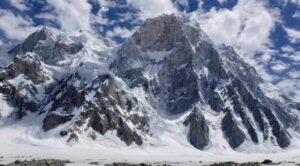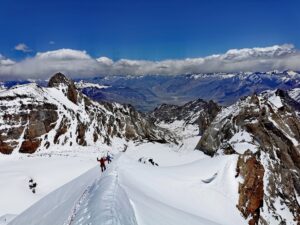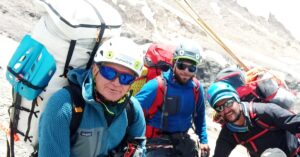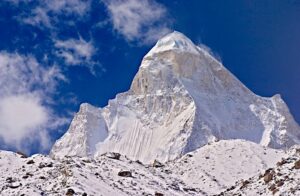Over the last 12 months, ExplorersWeb has documented incredible adventures in climbing, cycling, running, walking, skiing and anything involving force of will and dedication to a dream in the outdoors. As this year comes to a close, we present our countdown of the Top 10 Expeditions of 2019.
Do a Google search of his name and you’ll get 406,000 results. Ninety percent of the time, you’ll find the word “record” beside his name, often something like: “Ex-soldier climbs world’s 14 highest peaks in record time.”
No doubt we’re talking about the man of the year in the world of adventure. No one copped so many headlines or grabbed so many likes, retweets and comments on social media. He has a legion of fierce fans ready to defend their hero from the controversies that, oh yes, he has become involved in. Seemingly, no one represents high-altitude mountaineering in 2019 better than ex-Gurka soldier Nirmal “Nims” Purja. The question is not why he belongs on our Top Expeditions list but rather, why is he not in first place?

Nirmal Purja, determined not to forget the 8000’ers — and to leave them at his back.
Many will not need to read this article to come up with an answer that satisfies them: It’s just that we hate this guy at ExplorersWeb. Others might say that any story which strays from total, enthusiastic applause deserves a Twitterload of bitter comments. Such passion from an audience is amazing in itself. Not even Messner or Urubko raise such strong emotions.
But Nirmal Purja is much more than a mountaineer, a record-breaking athlete and a superb strategist. He has become a symbol of dreams come true, a pop star, a mountain influencer and, somehow, a master marketer of himself. However, let us also make our point, and in the process, review the meteoric rise of this Himalayan superman.
“Death, chaos and carnage” on Everest
Strangely enough, Nirmal Purja first became famous accidentally, not through himself and his merits, but when a picture he shot went viral and became the most printed pic in the world that day. It showed a tight queue of climbers on Everest’s Hillary step, well above 8,000m. The image perfectly symbolized the dark, selfish commercial side of Everest, “the mountain of egos”, and prefaced the “death, chaos and carnage” that followed. Eleven people died on Everest last spring, virtually none of them in a mountain accident. Rather, they succumbed to exhaustion, cold and exposure when they ran out of supplementary O2 during the long wait to ascend and descend.

The ultimate Everest traffic jam picture. Photo: Nirmal Purja
While the world debated what Everest had become, Purja fought to have, at least, his credit on the photo caption. He was struggling to raise funds for the months ahead, and it dismayed him that the public mood was to criticize Everest climbers collectively, instead of praising individual projects like his own.
As Purja reclaimed his credit as photographer, his Project Possible began to attract some attention. At first, most were skeptical, precisely because unlike a lot of so-called impossible firsts (see O’Brady, Colin), this one truly looked impossible. He wanted to summit all 14 8,000’ers in seven months. He would do whatever it took to maintain this torrid schedule. Mainly, he used helicopters to move from one mountain to another. He also enlisted rotating teams of extremely strong Sherpas who fixed the route and set up camps in advance, whenever possible. They also joined the tireless Purja on his summit bid. The fact is, before taking that infamous Everest pic, he had already chain-summited Annapurna, Dhaulagiri and (flying to the other side of the country) Kangchenjunga!

Nirmal Purja. Photo: Bremont Project Possible
In this fashion, after waiting in line with the rest of the crowds to tick off Everest, Purja literally ran to Lhotse and topped out there less than 11 hours later. He then took a chopper to Makalu, where he had a crew working on the route, and climbed that within five days.
Then to Pakistan, and Nanga Parbat, both Gasherbrums and K2. There, on the Savage Mountain, Purja showed his true colors as an expedition leader and an amazingly strong climber.
When he showed up at K2 Base Camp, the atmosphere was one of defeat. Most teams were packing up and heading home empty-handed. Dangerous conditions had forced back the Sherpa team of 7Summits and everyone else climbing behind.
Early fears of an encore of Everest crowds rapidly changed to expectations that K2 would remain unsummited this year. Then Nirmal Purja pulled a sort of high-altitude Julius Caesar: He came, he saw, he conquered. He had the vision and the courage to launch a full-force push and reached 8,000m. Here, he discovered that colder night temperatures had improved conditions enough for a summit attempt. That involved a little luck, but the really lucky ones were those who had remained around K2, because following in Purja’s footprints, they all summited. Even better, everyone made it safely back to Base Camp.

Nirmal Purja begins his descent from the summit of K2. Photo: Bremont Project Possible
Purja next sped up Broad Peak. He then had some days to rest and devote himself to fundraising for the last leg of his project, which included Manaslu, Cho Oyu and Shishapangma.
Chinese restrictions on the latter two peaks, both climbed from Tibet, added suspense to the quest, which by now no one considered impossible but extremely exciting. Changing plans on the fly, Purja and his team postponed Manaslu, crossed to Tibet and climbed Cho Oyu, which was about to close to foreigners on October 1.
He then returned to Nepal, finished Manaslu (or so it was claimed) and launched an intensive campaign to obtain a special permit from China to climb Shishapangma. Somehow, he succeeded. On October 29, he reportedly summited and therefore completed a project which had evolved from a crazy dream to an amazing race against the mountains and the clock and ended up writing a new page in mountaineering history.

Nirmal Purja, second from the left, with part of his star Sherpa team. Photo: Bremont Project Possible
For the record, this is the official list of summits, as provided by Purja’s PR team:
1. Annapurna April 23
2. Dhaulagiri May 12
3. Kanchenjunga May 15
4. Everest May 22
5. Lhotse May 22
6. Makalu May 24
7. Nanga Parbat July 3
8. Gasherbrum I July 15
9. Gasherbrum II July 18
10. K2 July 24
11. Broad Peak July 26
12. Cho Oyu September 23
13. Manaslu September 27
14. Shishapangma October 29
This whirlwind of activity all seemingly ended in success. So where has Purja fallen a little short in our assessment?
As in all human endeavours, Purja’s climbing history is not only made of lights. The shadows fall on the methods he used, the overall use of supplementary O2, rotating soldier-like crews and the chopper lifts when available (mainly in Nepal). In a post some weeks ago, Purja affected shock at the signs of climate change in the Himalaya, but his own project was far from carbon-friendly and sustainable.
It was clear early on that Purja’s quest was not going to be an example of alpine-style climbing. But that is, after all, a matter of personal choice. His methods were not exactly elegant, but he broke no law.
His social media posts typically highlighted his own strength and leadership, which disturbed those who believed that mountaineers should show some humility in the face of nature. But let’s not forget that Purja served in the Gurkas and the UK special forces for over a decade, so he speaks as a soldier rather than as an explorer, a traditional mountaineer or a lover of the outdoors.

Nirmal Purja. Photo: Project Possible
What his posts lack, and this does concern ExplorersWeb, are details. Simple climbing reports with facts, references and clear photos. What happened on the Gasherbrums, how did the climb on Cho Oyu go, what was Shishapangma’s summit ridge like? Upon completing Project Possible, Purja’s PR team released an official report and a set of summit pictures, but most of them showed no altitude or geographical references, which are commonly used by climbers to provide summit proof when claiming records.

NIrmal Purja on the summit of Broad Peak. No geographical or altitude references are shown. Photo: Bremont Project Possible
Even the project’s secondary objectives were slightly blurred. What first seemed to be a charity awareness-raising campaign eventually morphed into a subtle advertisement for Purja’s climbing agency, Elite Himalayan Adventures.
In fact, Purja’s work as expedition outfitter also became mired in controversy when he helped drape a giant flag of Kuwait over the summit of Ama Dablam, as part of an image event planned by some Kuwaiti clients. The stunt didn’t impress local guides and was apparently done without the proper permits. While it is unlikely that Purja will face any consequences, his carefully molded image may come out with some chipped corners.

Nirmal Purja, second from left, and his Project Possible team wave after successfully scaling all 14 mountains above 8,000m in just over six months. Photo: Skanda Gautam/THT
For his extraordinary ingenuity, his indomitable will and his absolute faith in his ability to make the impossible possible, Nirmal Purja deserves unanimous applause. His strategic skills, cool thinking in difficult circumstances, physical and mental strength and endurance for so many months are remarkable. But he is not just saying that he is an amazing expedition leader. He is stating that he successfully summited all 14 8,000’ers in under seven months — a factual claim that is not open to interpretation. To be accepted as a world record, this requires some proof, or in the absence of solid evidence, at least a good, credible recount of events.
Through the months, we at ExWeb applauded and covered all his summit claims, since we had no reason to doubt. But once the project was completed, we expected to see a debriefing somewhere. Some of Purja’s summits are clearly confirmed by images and the presence of fellow climbers. Others are not. There is no info on Broad Peak or Shishapangma. On Manaslu, moreover, his alleged summit pictures were taken from a spot which is not the mountain’s highest point.
Such an “almost summit” will surely suffice for most commercial clients who were there — but not for a world-record claim. Does this mean that Purja didn’t summit Manaslu? Did he climb any further than the point where the pic was shot? We can’t know, but in recent years, Manaslu’s summit claims have left too many unanswered questions.
This is why we hoped to ask Nirmal Purja himself. ExplorersWeb has tried to contact him for an interview, to clear up some details about his climbs, but his team has declined to speak to us. It is their right, of course, but then we also have the right to question certain of his claims.
For the sake of climbing history, we hope to see Project Possible’s climbing details published, wherever, whenever. The mountaineering community would profit by learning the whole story of this remarkable adventure.
One final thought: Nirmal Purja is not yet done in the mountains. He recently showed interest in attempting winter K2 in 2021 and he vowed that he’d do so without supplementary O2. And he has been teasing his followers with hints of other new challenges ahead. Hopefully, we will hear much more from him, have the chance to be astonished again by his drive and ambition, and would be delighted to rank him number one, which he clearly is in so many ways.
Related stories:
Purja and the Giant Flag on Ama Dablam
Exclusive Interview: Nirmal Purja
Himalayan Climbers Assess Purja’s Feat






